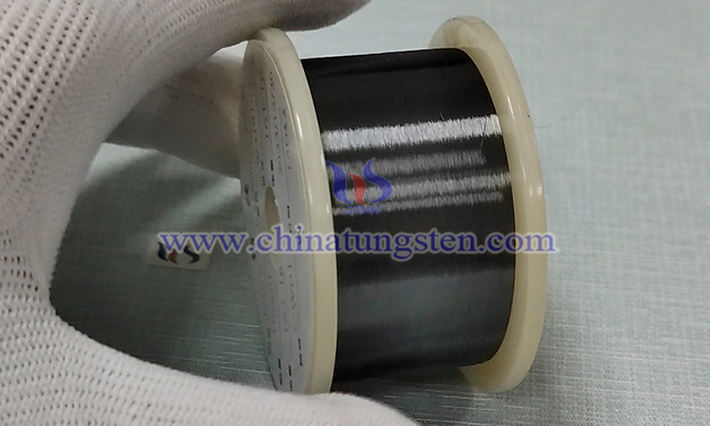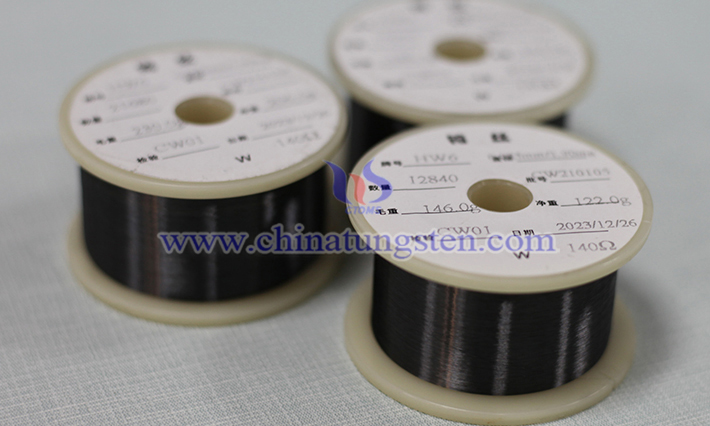Design Principle of Tungsten Wire in Glass Heating Equipment
- Details
- Category: Tungsten Information
- Published on Thursday, 26 June 2025 19:27
The core design of tungsten wire heating elements used in glass heating equipment (such as glass kilns, furnaces or vacuum coating equipment) is to use the extreme high temperature stability and efficient radiation heat transfer ability of tungsten metal to achieve uniform and rapid heating of glass in harsh environments. The following are its key design principles:

I. Material Selection: Excellent High Temperature Performance of Tungsten
1. Ultra-High Melting Point: This is the cornerstone of tungsten wire design. Glass processing (such as melting, softening, annealing, tempering) usually requires temperatures of up to 1500°C or more, and even some processes are close to 2000°C. Tungsten (melting point 3422°C) is one of the few metals that can maintain solid state and strength for a long time at such high temperatures.
2. Low Vapor Pressure: In high temperature and high vacuum environments (such as vacuum coating), tungsten is not easy to evaporate or sublimate, avoiding contamination of glass surfaces and equipment chambers, ensuring process purity and component life.
3. Excellent High Temperature Strength And Creep Resistance: Tungsten can still maintain sufficient mechanical strength at temperatures close to its melting point to resist sagging or deformation caused by its own gravity and thermal stress ("anti-sagging tungsten wire" is usually doped with elements such as potassium, silicon, and aluminum to enhance this performance).
4. Good Thermal Stability and Low Thermal Expansion Coefficient: Tungsten is relatively stable in size under high temperature cycles, reducing the risk of fracture caused by thermal stress.
5. High Resistivity: Tungsten has a high resistivity (about 5.6×10⁻⁸ Ω·m, 20°C), and it increases significantly with increasing temperature, which is conducive to obtaining the required resistance value through a reasonable length of wire in a limited space, and realizing efficient electrothermal conversion.
II. Principle of Thermal Radiation: The Main Heat Transfer Method
At high temperatures (especially >1000°C) and in vacuum or inert gas environments, convection and conduction have limited effects. The core function of tungsten filaments is to convert electrical energy into thermal radiation (infrared radiation).
According to the Stefan-Boltzmann law, the energy of black body radiation is proportional to the fourth power of its absolute temperature. Tungsten filaments are heated to very high temperatures (usually designed to be in the range of 2000°C - 2800°C) and become a powerful radiation source.
Tungsten has a relatively high emissivity at high temperatures (especially in the visible and near-infrared bands), which can effectively radiate heat in the form of electromagnetic waves, penetrate space, and be absorbed by glass.

III. Structural Design: Maximize Radiation Efficiency and Uniformity
1. Spiral Winding: This is the most common structure. Wind the straight tungsten filament into a spiral shape (single spiral, double spiral or even more complex shapes):
(1) Increase the effective radiation area: Significantly increase the surface area of the emitted radiation in a limited space.
(2) Improve power density: Allow higher current to pass through a relatively short physical length, achieving higher operating temperatures.
(3) Improve temperature uniformity: The spiral structure helps to distribute heat more evenly inside the filament.
(4) Adapt to installation space: It can be designed with different diameters and pitches to adapt to the shape of the furnace or chamber.
2. Reasonable Layout: Multiple tungsten filament elements need to be scientifically arranged in the heating chamber (such as parallel arrangement, grid shape, surrounding the workpiece, etc.) to ensure that heat can be evenly radiated to all surfaces of the target glass to avoid local overheating or cold spots.
3. Cold End Design: Both ends of the tungsten filament need to be connected to copper or nickel alloy electrodes. The temperature at the connection must be significantly lower than the working section of the tungsten filament, otherwise the electrode will melt or oxidize. The design often adopts:
(1) Increase the cross-sectional area of the cold end: Reduce the resistance of the cold end and reduce Joule heat.
(2) Water-cooled electrode clamp: Force cooling of the electrode connection area.
(3) Transition section design: Make the temperature transition smoothly from the high temperature of the working section to the low temperature of the cold end.
IV. Electrical Design: Power Matching and Control
1. Resistance Calculation: According to the required heating power, working voltage and current, combined with the resistivity of tungsten and its temperature coefficient, the length, diameter (or cross-sectional area) and spiral parameters of the tungsten wire are accurately calculated.
2. Power Supply Matching: Select or design a low-voltage, high-current power supply (such as a transformer, a thyristor rectifier) that can provide a stable and controllable large current.
3. Temperature Control: By precisely controlling the input power (voltage/current) or using thermocouple/infrared thermometer feedback, the temperature of the tungsten wire is accurately adjusted to control the radiation intensity and the heating temperature curve of the glass.
V. Environmental Protection: Extending Service Life
1. Vacuum or Inert Gas Protection: This is a key condition for tungsten wire to work for a long time at high temperature. Oxygen in the air will quickly oxidize tungsten at high temperature to form volatile tungsten trioxide (WO₃), resulting in thinning of the wire diameter or even wire breakage. It is usually used in a vacuum or inert/reducing atmosphere such as high-purity nitrogen, argon, and hydrogen.
2. Avoid Moisture and Pollutants: Moisture and hydrocarbon pollutants may also react with tungsten at high temperatures or cause hot carbon deposition, affecting performance and life. The equipment needs to be well sealed and baked for degassing.
VI. Life Consideration: Balancing Temperature and Time
The life of tungsten wire is mainly affected by the operating temperature, atmosphere purity and number of thermal cycles.
Follow the "10-15 degree rule": for every 10-15°C increase in temperature, the expected life of tungsten wire is approximately halved. The design needs to find the best balance between high efficiency (high temperature) and long life.
Doped tungsten wire (such as thoriated tungsten, rhenium tungsten, potassium silicon aluminum doped tungsten) generally has better sag resistance, ductility and recrystallization temperature than pure tungsten wire, thereby extending the high temperature service life.
- Chinatungsten Online: www.tungsten.com.cn
- CTIA GROUP LTD: en.ctia.group
- Tungsten News & Price: www.ctia.com.cn
- Molybdenum News & Price: news.molybdenum.com.cn
- Tel.: 86 592 5129696; Email: sales@chinatungsten.com



 sales@chinatungsten.com
sales@chinatungsten.com